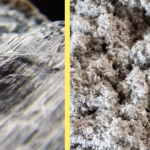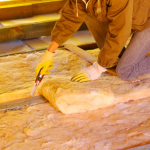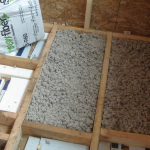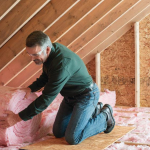
Insulation is the security blanket that prevents the house from overheating and experiencing cold pockets. Obviously, heat flows into colder areas, referred to as heat transfer. Insulation reduces transfer by restricting air flow. The insulating material secures tiny air pockets. The warm temperature of the house is maintained due to the insulation, as the air does not mix with the cold spaces.
It is mandatory for owners to periodically check their insulation. If there are sudden increase in heat bills and malfunctioning of the air conditioner, then changing the insulation work is the only solution. New homeowners must carry out quality inspections to determine if their insulation is tarnished by harmful asbestos material.
Any insulation work that is hazardous needs immediate replacement, but the problem is asbestos and cellulose insulation look the same. It can hardly be told apart, since the contamination risk is high with asbestos professional help is needed. In this article we shall differentiate between asbestos and cellulose insulation. This will help determine the kind of treatment your home needs for perfect heat solution.
Read More: Manitoba Hydro Power Smart Home Insulation Program
Asbestos Insulation Characteristics:
This insulator is derived from magnesium silicate. It has high resistance to heat and decay. In the United States, it was used between the years 1942 to 1999. This insulation product contains chrysotile asbestos which emits carcinogenic fibres when it comes in contact with water or moist conditions.
The most common types of asbestos insulation are thinsulate asbestos mats, Cement board cladding and transite boards. When mixed with cement it is referred to as cementious asbestos insulation. Plaster was used in its manufacturing process which contained tremolite or amosite asbestos.
It is a natural material that was widely used during the 50s through the 80s for home insulation process. It was commonly used for floor tiling, building and home heat solutions by construction companies back in the 80s. Later studies concluded that this material was cancerous and hence posed a health risk for humans. After the late 1980s, it was prohibited to be used as a major insulating material.
It is still in use with vermiculite insulation in most of the homes, making it a potential health hazard if particles are leaked and get airborne. Inhaling asbestos fibres can lead to dangerous medical conditions such as asbestosis and mesothelioma. These conditions directly affect the lungs and cause breathing malfunctions that often results in disability and death.
Cellulose Insulation Characteristics:
It is basically made of recycled paper. As the name suggests, it is manufactured from waste paper. On average, cellulose insulation has 90% post-consumer recycled paper content. This product benefits the environment by recycling old newspapers and magazines. Paper contains high amount of cellulose which acts as an excellent insulator because of its low thermal conductivity.

Cellulose insulation is manufactured from 80% post-industrial recycled paper and 20% other high quality fibres. The first layer of insulation house consists of rocks, stone wool, fibre glass and cellulose material followed by the second layer which has no cellulose content.
Read More: NB Power Home Insulation Energy Savings Program
Cellulose insulation is differentiated as dry cellulose, which is also referred to as loose-fill insulation and wet cellulose. It is the ideal alternative to asbestos insulation, this material is made out of newspaper, hemp, cardboard and straw. The builders normally mix these materials with boric acid to make cellulose insulation fire resistant. It effortlessly fits around walls, pipes and electrical wiring.
The dry cellulose i.e. loose-fill insulation is blown into the wall cavities with a blower, sometimes they fit into the holes. On the other hand wet cellulose is applied onto newly constructed walls to complete the insulation process. The only difference in both these processes is that water proves to be an effective sealant for wet cellulose insulation. This makes it easier to trap the heat in the wall crevices.
Cellulose insulation is part of the environmental consciousness movement – the materials used for creating this alternative to asbestos insulation thoroughly recycled. This makes it an easy option for builders seeking to invest in environmentally friendly projects.
How to tell the difference between cellulose and asbestos insulation:
It is hard to tell these two material apart since they look the same when it comes to inspecting insulation on a personal level. Hence it is advised to take expert opinion, homeowners must not touch the exposed part instead call for professional help. The material can then be extracted for careful examination and determined whether it contains asbestos or not. Risk is posed only if the asbestos fibers mix with the air system, hence better not try to solve the insulation problem without any specialist abatement company. They will immediately come and seal off the area and safely remove the hazardous material.
A reverse air system will be used to keep the airborne asbestos away from the occupants of the house. Thus maintain a clean environment in the affected home without causing any health effects.
In order to determine if the material contains asbestos, a special type of lighting must be used. In this light, any chrysotile fibers that are present will fluoresce under ultraviolet light. This test is not always accurate since it can give a false positive result.
A more specific way available in Australia and Europe to positively identify whether material contains asbestos is by running an electron microscope test. It identifies the exact species of the material being tested so it can be determined for certain whether or not it is contaminated with asbestos.
Cellulose insulation on its own does not have any health risks associated with it, but once it starts to break down, small particles are released into the air. If it is wet, then this can pose a health risk as these particles could potentially contaminate the surrounding materials and objects within the home.
In case of dry insulation, cellulose does not emit any airborne particles, hence poses no threat at all to occupants of the home or other people living nearby.
This product has been used widely in Canada and USA since it is non-toxic. Some examples of cellulose insulation products on the market include:
Tovec Thermafiber
Cellufoam
Korec Cellulose Insulation
Kingspan Cellulose Insulation
and many more…
All these products are available in Canada as well as in USA
Cellulose insulation is a strong candidate to replace asbestos insulation since it is available at a cheaper price and has no health risk associated with it. The only drawback is that the product breaks down over time, does not cause any fire hazard and is not as effective as compared to fiberglass.
In addition, cellulose insulation has a higher R-Value than fiberglass and is environmentally friendly. It is also easy to work with since it can be applied by hand. This makes it an attractive proposition for both the homeowners as well as the construction industry at large.
Cellulose insulation is expected to receive approval from various building regulations in Europe, Canada and the United States in the near future. Once it becomes an approved material, it will be used extensively for insulation of new buildings and home renovation projects across the globe.
Guidelines for Homeowners who have asbestos insulation:
a. Keeping children off the asbestos exposed area limits
b. Leaving the area untouched and always under supervision to prevent health scare.
c. Putting up safety measures to contain the spread of the asbestos fiber through the air particles.
d. Avoid to sweep and vacuum the area without any professional help.
e. Engage experts in the removal of asbestos insulation.
f. Avoid scrapping, drilling and construction activities around the affected area.
g. In case the asbestos is discovered on the floor tiles then avoid scrapping or brushing the floor. This will allow the asbestos particles to escape into the air system causing lasting damage.
h. Discard footwear and clothing which have been exposed to the material. Make sure to use a wet mop if in case you have stepped onto the asbestos fibers. Call the professionals to clean the house to keep your family safe.
There are no tell tale signs to differentiate between both cellulose and asbestos materials, hence it is better to leave it to the experts to decide. As a smart homeowner, it is advisable to check the insulation system whenever one buys or sells a property. It is important to replace old insulation to maintain the heat level of the house. And as an existing homeowner make sure to invest in professional services for periodic checks on the insulation system. After all, we cannot put our loved ones at risk with defective isolation.






Leave a Reply